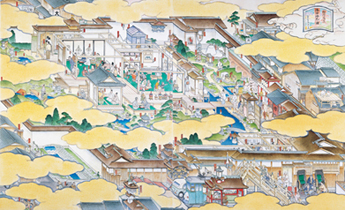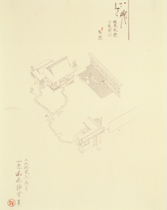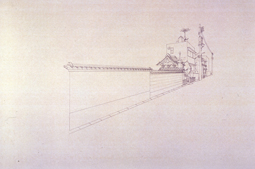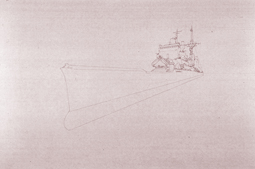 |
|
 |
| "'Mitate' in the House: Rakuchu-Rakugaizu" (2008) |
|
"'Tea Ceremony Room' Mechanical" (2000) |
|
The 19th century critical art historian Karl Schnasse developed a view of the continuities and transformations in art whereby the historian could see in individual works the intimations of what came earlier and later. Akira Yamaguchi creates a heady corollary to that methodological concern. He redeploys earlier forms, styles and motifs from Japanese art, combines them with the life of the present, and proposes an improbable future.
"Native Troops" (2008), which appears in the exhibition of Yamaguchi's work currently at the Asahi Beer Oyamazaki Villa Museum outside Kyoto, is a case in point. Here locals of years gone by, dressed in loincloths and shawls and armed with spears and bows, rest at mountain's edge where sprout stylized Kano school bamboo and pine trees. A modern-day pickup truck is parked in the middle distance with a couple of figures armed with rocket launchers. A fanciful fusion of super-charged motorbike with horse's head looks forward to a time unknown to the present.
Yamaguchi has noted that "one of the tasks of contemporary artists is to give new life to dead works," which he does by sampling Japanese art historical antecedents such as the Rakuchu Rakugaizu ("Scenes from in and out of the capital") or commemorative portraits of deities and warriors, as if they constituted both a visual storehouse to be ransacked and a contemporary novelty to be freed from earlier contextual functions and meanings.
The approach leads Yamaguchi to make some startling intrusions into the idyll of history. Reconfiguring the yesteryear of Oyamazaki, which is the artist's brief in the present exhibition, Yamaguchi comes to rest on the theme of a battle that took place between Hashiba (Toyotomi) Hideyoshi and Akechi Mitsuhide in 1582. Akechi becomes the protagonist in the "Last Supper" (2008), where he sits to dine with eleven comrades, yoked to the religious theme of Christ's final days. Here, however, the twelve enjoy supper in military garb, though there is little coherence to the group, who neither converse nor engage and often face away from each other. Further artistic eccentricities abound in the figures of the two midgets, one of whom sits beneath the main table in his own private seat at the feet of another. A fellow at left swirls a brandy.
Other Yamaguchi themes are mechanization and militarization. In the first, Yamaguchi finds "an element of beauty in machinery that aesthetically complements the beauty of nature" -- as in "The Battleplane of Orchid II" (2008), a motorized orchid bloom imagined from various vantages. Elsewhere one finds the mechanization of tradition. In "Horse for Open-Air Tea Ceremony" (2008), a samurai sits on a stool behind a horse stationed before him; an attendant prepares tea from a cabinet which has ejected from the side of the horse like a VHS cassette from a video player.
The militarization thread follows a similar structure. In the diptych drawing "Temple Street/Warship" (1999), the roadside facade of temple wall and residential housing area in careful draughtsmanship is made to appear as a navy battle cruiser in the adjacent drawing with a few deft additions and erasures. Tradition, too, is further militarized in the long historical association of warriors and tea ceremony, renovated to accommodate satellite dishes attached to the "'Tea Ceremony Room' Mechanical" (2000), guarded by armed infantrymen at the front gate and a little figure with a walkie-talkie out back.
Part of Yamaguchi's appropriation of Japanese art history means that he picks up styles and themes which never really develop beyond the gloss the artist initially gives them, and so become repetitive, though there is certainly demand for replicas. The historical Rakuchu Rakugaizu scenes conventionally represented the ancient capital of Kyoto, but in Yamaguchi's labyrinthine cityscapes, the current capital Tokyo becomes the focal metropolis. With ever-expanding commercial tastes, easy to understand and enjoyable art like Yamaguchi's is happily appropriated, as in earlier works such as "Department Store: New Nihonbashi Mitsukoshi" (2004), which was commissioned for the centennial of the Mitsukoshi department store in Tokyo, and in the present exhibition. Here there is a geographical shift but a familiar format, designs and motifs, as in "Transportation in Oyamazaki" (2008). No longer merely redeploying the art of the past, Yamaguchi is now in the position of redeploying even his own most recent works, establishing a kind of stylistic brand.
Two works in the exhibition suggest new directions. "Kitchen in Green" (2008) is a painterly work, unusual in Yamaguchi's recent oeuvre, with quick broad strokes over a blurry figuration of men at work. The piece seems a nod in the direction of the smudgy abstraction/figuration of British artist Cecily Brown. The eruption of rainbow color in "Takayama Ukon Playing Cembalo" (2008), portraying a Christian daimyo of the 16th century, is less successful for its unresolved blend of figurative line work and flourishes of paint.
Still, Yamaguchi's oeuvre is a chaotic history and future, flying in two directions from a revitalized hedonism in the present. Play and parody are always good fun.
 |
|
 |
| "Temple Street/Warship" (1999) |
|
"Temple Street/Warship" (1999) |
|
|
|